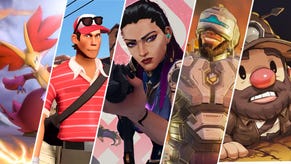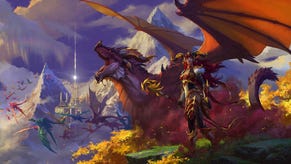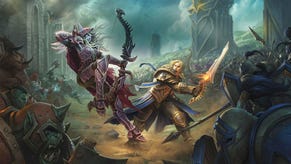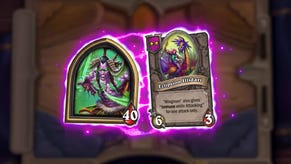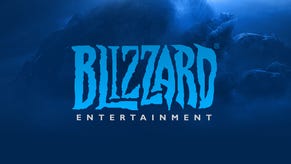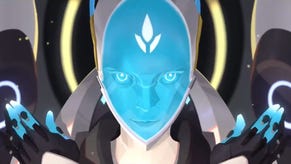Whispers of the Old Gods: Designing C'Thun, the State of the Hunter, and Lessons Learned From The Grand Tournament
HEARTHSTONE INTERVIEW: Designer Dean Ayala goes in-depth on the upcoming expansion.
This article first appeared on USgamer, a partner publication of VG247. Some content, such as this article, has been migrated to VG247 for posterity after USgamer's closure - but it has not been edited or further vetted by the VG247 team.
Whispers of the Old Gods is a pretty momentous expansion for Hearthstone. Aside from injecting new cards, it will usher in the new Standard metagame, which will retire a number of powerful cards (or least put them on hiatus). Hearthstone 2.0 has arrived.
I recently had the chance to talk with Hearthstone designer Dean Ayala about the upcoming expansion, and we wound up going in-depth on the nitty gritty of designing new cards, the state of the Hunter class, and what he learned from The Grand Tournament.
USgamer: Well, I suppose the first thing I'm going to ask is, when I think about where Hearthstone is right now, it's two years old at this point.
Dean Ayala About that, yeah.
USG: It feels like a turning point where now you're big enough to semi-retire certain expansions and that kind of thing. In that light, it almost feels like you're moving to Hearthstone 2.0, that this is kind of setting the stage for everything that's come, almost setting the tone, I guess. How much pressure are you feeling to really make Whispers of the Old Gods great?
DA: Honestly, I don't think any more pressure than any other set. At least for Standard and Wild, it really just felt it was the right time to do something like that, sort of like it was the right time to do Tavern Brawl. We felt that that was necessary to give people a new way to play Hearthstone, and standard is sort of the same thing. It's like, now is the time to do that. I think that doing it sooner is better. I think that maybe we didn't absolutely need to separate the card pool at this point. There aren't, I don't think that there are a crazy amount of cards right now that it is totally insane to get into Hearthstone, but eventually we are going to have to do it. So, I think doing it early on and setting the stage for that and getting lots of feedback and seeing what the Wild format turns out to be, and how many people are playing that and are passionate about that versus how many people are passionate about playing Standard.
Doing all that stuff as early as possible I think is better, but in terms of Hearthstone 2.0, I think it is going to be Hearthstone 2.0 for the very very engaged players, the people that have been seeing sort of different things as new sets come out, but really just different things based on what already existed, whereas now a lot of things are going to be changing. If you are really really engaged and you know the history of all the decks and all the metas, this is definitely going to be something a lot different. I guess the most difficult challenge for me personally is, when we're tuning new sets, we sort of look at, what exists already. Let's make sure we don't make the most powerful things more powerful, and let's make sure, we have some existing things that are cool and are almost there, so let's give them a little bit of a bump, and that way it's a little bit easier to see where the meta's sort of going to shake out. For Standard, it hasn't existed before, it hasn't really existed before, which is really really exciting on the one hand, because we definitely know that there are going to be all kinds of new decks, and a totally new meta, and people are going to be experimenting for a long time.
On the other hand, we don't really have, this is what it was, and let's make some changes to that. It's completely new. So, that's really exciting, but it's also challenging. It's almost like starting Hearthstone from scratch before anyone really played it, balancing that and making sure there's nothing too crazy overpowered out there. But it's just really exciting for us. I tthink people are going to experience something new, regardless of what player type they are.
"I really hope that there's all kinds of different decks out there, and if you want to play any class there's a couple different decks that you can choose from. If there's one answer for Druid, and there's one answer for Mage, and those are the two decks that people play, that's really the worst case scenario for me."
USG: I was going to ask, yeah, you're not only creating a total unknown sort of metagame with the standard version, because you're taking out a couple of expansions and then kind of giving League of Explorers and the Grand Tournament room to breathe, and Blackrock, as well. But, you don't know how that's going to shake out, you don't know what cards are going to emerge, and then you're adding on Whispers of the Old Gods on top of that. What's your biggest anxiety with that, that you want to make sure you get it right?
DA: I think that, it's really important that people are really excited about Old Gods, so, like I was kind of saying before, when you're pushing new cards in a new set, when we're making League of Explorers, we can say, "Oh, hey, these are kind of what exist, and let's push arena decks and style deck because we think that will really fit in with what's going on." Whereas with Old Gods, we really want to push the crazy cool stuff, because we want people to play it and we want people to be excited about it; but at the same time we just don't have the reference that we have had in the past. So, my anxiety is always kind of, I really hope that we got it right. I really hope that there's all kinds of different decks out there, and if you want to play any class there's a couple different decks that you can choose from. If there's one answer for Druid, and there's one answer for Mage, and those are the two decks that people play, that's really the worst case scenario for me. Well, for I guess everybody. But I don't think that's the case, so I'm not really feeling anxious about it, but that's kind of the thing you try to shoot not to do.
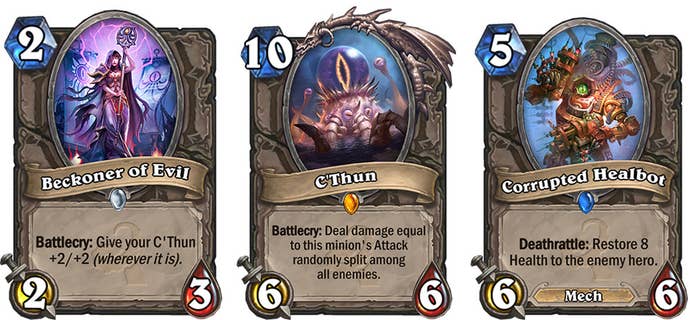
USG: So, the last expansion, you did League of Explorers, but that was a little different. The last straight card expansion was Grand Tournament, and that one, it had some hype, but it didn't make as much of an impact as many seemed to expect it would. Justicar Trueheart and Mysterious Challenger, obviously, had a big impact, but a lot of the other stuff didn't. I suppose it's a double pronged question. How do you think the new metagame is going to help the Grand Tournament, andwhat are some of the lessons that you learned from the Grand Tournament in making Whispers of the Old Gods?
DA: That's a pretty good question. I'll address the second one first, because I think we did learn a lot from the Grand Tournament. In terms of the actual number of cards that made an impact in the Grand Tournament, I actually think it's pretty high and about the same level percentage wise as some of the other sets that we've done. But something to learn from that was, I'm terrible. Darnassus Aspirant was a card that a lot of people played. A lot of people played Savage Combatant and played cards like Living Roots. But it wasn't the amount of cards that you insert into a deck that makes it new, really. It's just like, oh, we've seen the Druid that casts creatures and plays Wild Growth. And yeah, you're adding cards to that, but it's the same deck, it plays the same way. It doesn't feel different. So, that's sort of a lesson to us. You can't just insert new options for people in their deck if it's the same type, because it doesn't feel new. So in terms of learning lessons from that, with League of Explorers we made sure to create cards that not only are cards, these are cards that people are going to get excited about, but it also was creating a new deck that feels actually different, it's not just a tweak onto the same thing that people have been playing. So, that's really really important to us, and I think that's the biggest lesson learned from all of the decks.
Cards like Reno Jackson... it's really one card. And you can just have Reno Jackson, and you can have 29 cards that everyone has seen before, but it's a new deck, and it's sort of like a new experience, which is really important. We always are preaching, "Let's build cards that will let you build a deck that people will not have seen before." So, I guess that's a lesson learned from there. And as far as this helping the Grand Tournament, I'm not sure if helping's the right word, but clearly, there's a lot of powerful cards in Goblins vs Gnomes and Naxxramas, and because a lot of those cards are leaving the card pool, that makes cards from the Grand Tournament become a little bit more, I'm not sure viable is the right word, but attractive, I guess. Oh, it's like, I don't have all of these options anymore, so, what are the options that I can explore? There's going to be all the crazy stuff we do in Old Gods, that's really exciting, I hope, that is on a similar power level to everything else, so you have lots of options, but you're going to be looking back at cards from Blackrock and cards from Grand Tournament and saying, “Oh, I didn't play this, I played Shredder, or I played Dr. Boom, or I played Minibot. What can I look for in those sets to replace what I was doing before?”
Everybody's going to go, “Oh, I didn't play this guy before,” but now maybe you do, because you need to fill those slots, if you're planning on playing standard.
USG: Let's talk about C'Thun a little bit. The thing that kind of jumped out at me, really fast card, gives you immediate value when you throw him out there. Is this one of those lessons learned, that when you put out a big card like this it needs to give you immediate value?
DA: I'm not sure that that's really a lesson learned, because we know that for the most part. If we're going to make a 10 mana card, it's going to have to be pretty insane, because getting to 10 mana in the first place is not exactly the easiest thing to do. We know that. Making 10 mana cards is challenging for that reason, because it's a tricky balance. Because, if you make a card variant, say. Put three cards on the battlefield, draw three cards and put them on the battlefield. That's insane, that's a crazy effect, but because he's 10 mana, he still doesn't really see that much play, really. So you have to make those effects really powerful, to the point where they're almost winning you the game, but at the same time you don't want to make a card that says win the game either, so it's really about finding where the balance is there, where, “We need to make it exciting, it costs so much mana,” but it can't just win you the game instantly, really, because that would be a bit frustrating every time you got to 10 mana you're going to lose the game.
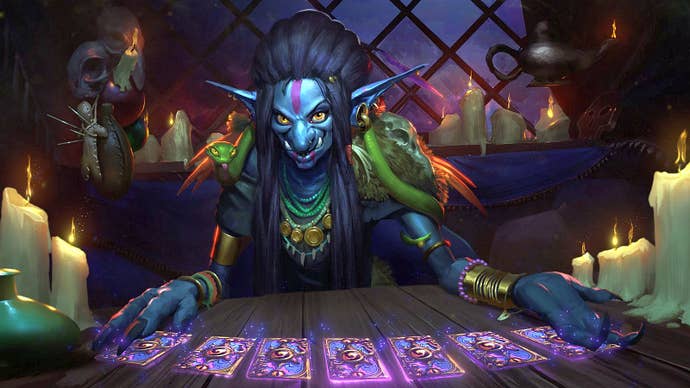
USG: I just think about Rafaam from League of Explorers, where, it's a cool card, but the effects, like, the fill the board effect is obviously the best one, but it feels like it's so easy to just be like, boom, board clear right off the bat.
DA: Yeah, I think, I mean, there's a place for those cards, cause like, Ysera is sort of in the same light, where, Ysera doesn't really do anything when you put it on the board for 9 mana. It's really slow, it generates value over time. But that has seen play in the past, where, the meta slows down a lot, and people play not as aggressive kinds of decks, or Secret Paladin goes away in Standard, and maybe people are starting to play more and more control decks. I think someone like Arch-Thief Rafaam, he's going to show up, because if the meta's really slow, he generates a ton of value, it's just about finding the right time for him to show up. I just don't think it's the way the meta kind of shook out, is the way he didn't get played, but there's certainly a scenario that exists where he would, and I feel that way about basically all the 8 to 10 mana cards, or really any card in Hearthstone. There's always a time and a place for all of these cards, so you just have to find the right moment for them.
USG: I feel like the most successful 10 mana card in history is, what, Pyroblast, for the Mage?
DA: Yeah, that's sort of what I was talking about where the balance, because Pyroblast is kind of a card where, in a lot of situations where Pyroblast is winning you the game, and that's why it's powerful.
USG: It's kind of the same with C'Thun, right?
DA: Yes and no. I think C'Thun is going to, in playtesting, the answer to C'Thun has been like keep generating a board, and if you have a big enough board at the time, it's really really difficult to get C'Thun to 30/30 or something like that. If you have 10 healthy creatures on the board, he might kill them, but if you have a removal card, he's going to do a little bit of damage to you and he's going to clear your board, but they're going to put in a lot of work and you're going to be able to deal with it. At least, that's the hope. C'Thun's super exciting to me. It's really hard to see exactly what he's going to do. It seems like it's going to be the same strategy. You buff up C'Thun and then you just destroy everything on turn 10, but, I'm pretty excited to reveal some of the other things we're doing with C'Thun. Obviously, I can't really talk about any of that right now, but, we're dedicating a lot of cards to C'Thun, right? There's 16 cards that interact with C'Thun, and that would make me a lot more nervous if there weren't different types of C'Thun decks. Like, the different classes based on the different cards they have that interact with C'Thun are, those decks are going to play out a lot differently. So, if you don't like how one C'Thun deck plays out, I think there are going to be more options for you that are going to play a lot differently. Some of those options are going to be like, “Make an enormous C'Thun and try to kill your opponent on turn 10.” And some of the other interactions might be a little bit different than that. So I think more of that will be told as we start releasing more cards, but I'm really excited for all the types of C'Thun decks there's going to be.
USG: So you want a lot of different archetypes out of one card, essentially.
DA: Kind of. I mean, it's more like 17 cards, I would like a bunch of different archetypes of. But that's really the goal of all of our stuff. We don't want to create just one deck.
USG: And you're giving everybody a free C'Thun just to jumpstart that, essentially.
DA: Yeah, I think that's really cool. I was really really happy with the decision to do that, because it really stems from, we have this super super cool idea. You have all of these cards and they buff up this card, and you have the vision of building up this giant C'Thun. I don't know, it's really cool to build your own monster kind of thing. But the card's a legendary card, as it should be. It's C'Thun, he's an old god, it's the old god set, of course he's going to be a legendary. And we want all of those cards to interact with him, and they're going to be common and rare and maybe some epics. It feels pretty bad to open up a pack and it's three commons that interact with an epic that you don't have. So, for C'Thun specifically, we didn't go into Old Gods and say, to generate more interest, we're just going to give people a legendary. We have this really cool idea, and we thought that, you know what, it's going to feel really bad if you open up all these cards and you don't have C'Thun. So you know what, let's just give them C'Thun. We don't want to scrap this idea, we don't want people to feel like they can't build their deck because they're roadblocked because they don't have this legendary. We sat around and kind of talked about it, and it's like, "What if we just give them C'Thun?" You know what, we really liked that idea. So it's really cool that we, we came to that conclusion, it's like, "Yeah, let's just do that, it feels like the right thing to do."
USG: Are you nervous that he won't find a place in the metagame and suddenly half of Old Gods is shot?
DA: No, not really. That's kind of what I was talking about. It's certainly not half either way, it's 17 out of 134 cards. But on top of that, yeah, I would, because that is a lot of the set to dedicate to one deck, but like I was saying before, I think it is multiple decks. Sort of like, I mean, Reno Jackson doesn't have 16 cards attached to him, but there's different Reno decks that you can make. They're similar in some ways, but you can do it in Mage, you can do it in Warrior, you can do it in Warlock, and they're different decks, and I think different people will gravitate towards – because maybe you'll really like playing Warlock, and maybe you'll really like playing Rogue or Druid, and C'Thun fits in one of those decks. So, I think there are multiple different avenues you can go to really enjoy yourself with that specific card.
USG: This is more of a minutiae question. I noticed that the common Cultist minions mostly favor body over attack. The two mana drop had three health, which made him a little bit sticky, and the three mana drop had four health, which is reasonably big body for a big three mana drop. Not huge or anything, but decent. Why were you favoring body over attack?
DA: I don't think there's a really good answer for that. We just look at every card, and we say, "OK, this is the deck that it plays out in." And we play that deck, and we see how all the cards interact with each other, and I was like, “Oh, this makes more sense, or this fits a little bit better, this feels a little bit better.” And it's also a very small subset of the cards, so, I wouldn't really even say that that would be a trend going forward. I think those are the cards that we chose to reveal, and maybe there might be something ot it, but I don't think – maybe from the people viewing it's perspective, there might be something to it, but I don't think there is. That's kind of how those specific cards shook out.
USG: What I was playing, I threw out the Validated Doomsayer out there a few times. I think he's a five drop, who can become 7/7. And the thing that I found was that my opponent just went out of their way to kill him immediately, because he had a chance to become a giant threat. And instantly removing him from the board without removing him from the board on the first term didn't hurt him at all, because obviously he didn't have any attack. So, it felt a little bit like a waste, like there was a big risk reward component to it. What's your take on this?
DA: I really like that card. Part of the reason is that the best cards, from my perspective, are the ones that reward you in the cases where you work around it, and they do not reward you if you aren't trying to find the way to play that card in the best scenario. For that card in particular, I think the way to take advantage of that is to play decks like Zoo, as it is now, or like Egg Druid, or something like that. A deck that almost always has board control, because he's the perfect card to play on an empty board. If you find yourself in a situation where you're playing a deck and you consistently have board advantage and your opponent doesn't have a lot of creatures to overthrow your minions, he's great, because he's 0/7, there's not a lot to deal with that. Priests have a Shadow Word: Death, and there's Big Game Hunter and stuff, and you can't deal with that card.
USG: But you don't even get instant removal with Big Game Hunter.
DA: Exactly, so, he's actually very very difficult to remove from hand, whereas a lot of the other big creatures, they have the problem of being removed by some of those removal spells. So, I think if you build around that card specifically and put that card in a position to be a 7/7 when your opponent doesn't have a lot of stuff on the board, then he's going to be super strong, which is awesome to me, because I built a deck around, I needed to have board control, and I played this card on turn 5, and I got rewarded because I thought about it. I didn't just throw the card in my deck and really expect it to work out all the time, because cards that you play and they're always good, that's not really something that I'm really excited about.
USG: Let's talk about Hunter really quickly. The Hunter really suffered in League of Explorers, arguably, because Reno Jackson came in and a lot of the cards came in and Mid-Range Hunter got outclassed, and Face Hunter had a harder time being consistent, and so it fell off. So, how do you kind of address that? What's the new way to play for a Hunter that's built around aggro, that kind of thing?
DA: I think that when, it's sort of like, Face Hunter is a very specific archetype of deck that people are running, and when there's a lot of Healbots and Paladins playing Lay on Hands and whatever the Murlock deck is of the month, and everyone running around with Reno Jackson, that's a deck that's going to suffer. The meta is shaking out in a way right now where that deck is probably not your best way to play that deck right now. In the future, I don't know that that's the case. I think that deck's still good, it's just not really the time for it right now, because there are so many Reno things going on. Actually, Hunter specifically right now, it's actually pretty viable. We've seen a lot of people, data wise, ladder doing very well, and the last, the Rank 1 legend person for Europe was playing some version of Camel Hunter. Not something that I've played in playtesting. I was like, "Wow, that's creative."
"The community always gets there. Every time I see one of these decks on whatever dashboard that I have and it's not being played a lot, it's like, "Oh, this is very successful, this is very good, but they haven't figured it out yet." They always figure it out."
USG: Yeah, I tried out the camel.
DA: Yeah, I played it after the fact. I was like, "Wow, that's pretty good." So, I think that there's certainly a place for that. I'm playing a lot of Hunter right now with King Krush in it, strangely enough. And, we actually have, I'll sort of reveal this. We have a bunch of data. We have data for almost anything you can think of. Certainly, win rates of all the classes, and we also have sort of a dashboard of all the top whatever, 200 players and the deck that they use when they're doing that. So, whenever they're doing that, something that I do regularly is I look at all the stuff, and it's like, Oh, there's someone playing Ranger or whatever deck that I've seen before. And if there's anything that's like, Oh, this feels a little different to me, but this person is obviously very successful with it, I sort of look at that and I go online and I play it.
I play like, you know, 100 games, 200 games with it, to see, what makes that successful, and see if that's really fun. Because people don't realize it's really that good yet, but obviously at least someone's successful with it. So, I'll look at it and say, "What is it about this that is cool, because it's obviously successful, and how can we motivate people to play like this, because it's fun, but people don't really realize it yet." And, a couple of those decks that I played were Hunter decks. So I think that, I know that that class is in a good position right now, but I don't think people have really figured it out yet. And, that's really cool to me, because I know that they'll get there. The community always gets there. Every time I see one of these decks on whatever dashboard that I have and it's not being played a lot, it's like, "Oh, this is very successful, this is very good, but they haven't figured it out yet." They always figure it out. It might take a week, it might take a day, it might take a month, but they always always figure it out. So, I think Hunter is going to be fine.
Whether or not people figure out what it is they need to be doing with Hunter before the next expansion, I don't know, but we go out of our way to try and support all the classes. We're not going to go out of our way to try to support Secret Paladin next expansion. I don't think that's a secret. I didn't intend to make that a pun. But I don't think it's a secret that we're not going to support that type. A lot of people are playing it. I think it's fine. It created a new deck that no one has seen before. I think it's being played at a higher rate than I would like. I think even the most fun deck on earth, it doesn't matter how cool it is, if it's comprising 30 percent of the games in Hearthstone. People are just going to get tired of playing against it. So I think with Secret Paladin, the volume of games that is being played of Secret Paladin is really kind of wearing people out, so I think because of that, regardless of win rate, regardless of how powerful something is, you don't really want to support things that are getting played a crazy amount. Because you always want different experiences. You don't want to log in to Hearthstone and play the same three decks over and over. That's probably the most important thing to me, is creating a very fun experience for people, so they can login and be inspired by all the different things that they saw and try to build more decks.
USG: Are you happy with where it is in terms of speed right now?
DA: I am, yeah. I think it is the right timing for now. But like I said, we haven't launched twenty new sets or anything, so we're still in the times where, there's not a crazy number of cards, so we're still figuring out what it means to be a new player and come into the game and figure out what's going on. I think over time we'll learn more.
USG: What's your hope or expectation for this year's metagame?
DA: Well, at least initially, I'm very confident that people will see all kinds of new stuff, because, obviously, that's going to happen. You just look at, oh, look at whatever website you want or look at, play ten games on ladder and look at all those decks. Hmm, are those decks losing a lot of things? Yeah. So, you're going to see lots and lots of different stuff. People want to see, “Oh, you should rotate more often.” But I think it's truly enough. I think when we release a new set, there's time there where people are really figuring it out, and I think once you start announcing the new set everyone's kind of like, “Oh, this is figured out. I want the new stuff.”
So, I think that, Standard's going to happen, everything's going to be different. And it's going to be more experimentation than we've seen since the initial launch of Hearthstone, people are really figuring out how to play the game, then we're going to release a new set. And people are going to be crazy about that, wondering what's going to happen. And then we're going to release a new set, and then before you know it, when people are like, “Oh, you know, I understand this,” or “this is figured out,” and then two sets or three sets are going to go away and it's going to be like all over again. So I think every year is enough, and it's really the first time we're doing this. So, we're going to learn too, and we're sort of monitoring everything and looking at all the feedback, and if it's not fast enough we'll make it faster. If it's too fast, we'll slow it down. So, we're just kind of figuring that out for ourselves.
Whispers of the Old Gods launches on April 26.


